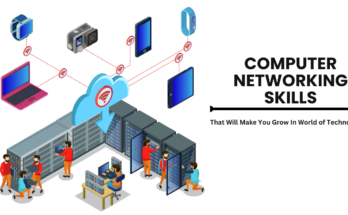The Evolution of Digital Network Architecture
The idea of Digital Network Architecture (DNA) has become a key concept in the ever changing field of technology, influencing how we interact and communicate. Network design, implementation, and management have undergone a paradigm change with DNA, which uses digital technology to improve security, flexibility, and performance. This article explores the essential elements, advantages, and revolutionary effects of Digital Network Architecture on the way enterprises organize their networks.

The Building Blocks of a Digital Network Architecture:
When attempting to understand the complexities of a Digital Network Architecture (DNA), a comparison can be made between the intricacy of a busy city. Just as a city depends on a carefully designed network of highways, bridges, and electricity systems, so too does a digital network architecture consist of linked building pieces that allow data to be transferred easily. The functionality and effectiveness of the overall network are supported by these essential elements.
- Devices: In the architecture of a digital network, devices act as the endpoints. These might be anything from the more durable servers and routers to the widely used laptops and cellphones. Similar to a city’s entrance and exit points, devices play a crucial role in the transmission and reception of data inside a network.
- Media: The physical channels that data travels via on a network are represented by media. This includes a wide range of conduits, such as wireless signals, coaxial cables, and fiber optic cables. These routes, which enable data to move between locations, are the digital equivalents of the complex transportation and road networks that wind through cities.
- Protocols: Protocols serve as the regulatory frameworks that control how devices interact with one another in a network. Similar to traffic signals and road signs in a city, protocols set down the guidelines necessary to guarantee the effective and seamless flow of data. They establish the language that gadgets must speak in order to communicate, adding to the digital metropolis’ overall cohesion.
- Network Functions: Network functions include all of the necessary services that are in charge of controlling and maximizing data flow inside the design. These consist of security protocols, switching, and routing. These roles are comparable to traffic controllers in terms of data direction, network police in terms of thwarting attacks, and maintenance workers in terms of making sure the entire system runs smoothly.
The Evolution of Network Architecture
The development of digital network architecture is similar to that of a city, which is marked by constant expansion and modification. Networks were initially very basic, connecting a few computers in a small physical area. As technology progressed and the need for connectivity increased over time, these networks grew larger and more complex. We observe the following network categories in the modern era:

- Local Area Networks (LANs): Local area networks, like those found in homes or offices, are made to link devices inside constrained physical spaces. At first, local area networks (LANs) allowed a few computers that were close to one another to communicate. LANs changed as technology developed to support a wider range of devices, establishing networked ecosystems inside particular spaces.
- Wide Area Networks (WANs): Wide Area Networks connect numerous LANs located in cities, nations, or even continents, allowing them to reach over greater distances. WANs are used to create smooth data exchange and communication across geographically separated locations. This extension takes care of the expanding demand for wider-ranging connectivity.
- Metropolitan Area Networks (MANs): Metropolitan Area Networks (MANNETs) serve areas like large campuses or cities inside designated metropolitan zones. Within a predetermined geographic area, these networks function to connect different local networks. MANs are designed to satisfy the particular requirements of heavily populated urban areas or major business and educational campuses.
- The Internet: Each of the networks are connected by the Internet, which is more than just LANs, WANs, and MANs. It acts as a worldwide network that transcends traditional geographic borders and includes a variety of network kinds. The digital era is becoming more interconnected as a result of the Internet’s ability to promote worldwide communication, teamwork, and information exchange.
The Impact of Digital Network Architecture
Digital Network Architecture (DNA) has a profound impact on many aspects of our globally interconnected environment, even beneath the surface. Its influence is fundamental, acting as the pivot for several important elements, such as:

Global Communication:
Digital network architecture is the foundation of international communication, facilitating a wide range of interactions over long distances. The network is essential to sustaining relationships between people, whether they are with family members or coworkers, on a worldwide level, whether it is through video chats that link people across continents or real-time messaging apps that facilitate communication.
E-commerce and Online Transactions:
Digital network architecture orchestrates the smooth flow of data, which is essential to the smooth operation of online transactions and e-commerce platforms. The secure movement of sensitive data is ensured by this architectural framework, which promotes the rapid expansion of digital banking, online shopping, and other financial operations. Thanks to a well-planned digital network, customers may simply utilize cloud services, which provide unmatched scalability and flexibility for computing, storage, and other applications.
Cloud Computing:
Digital network architecture is at the core of the paradigm shift towards cloud computing, offering a robust basis to support this game-changing technology. Users may access data and apps from anywhere in the world due to the intricate infrastructure. Customers can easily use cloud services, which offer unparalleled scalability and flexibility for computing, storage, and other applications, thanks to a well-planned digital network.
The Internet of Things (IoT):
Networks are necessary for basic data transfer in both industrial sensors and smart home gadgets. The network’s effectiveness guarantees that this enormous ecosystem of linked devices will remain cohesive, enabling harmonious operation and smooth information exchange. In the era of the Internet of Things, digital network architecture is what makes a connected and intelligent environment a reality.

The Future of Digital Network Architecture
The field of digital network architecture is positioned for ongoing change and adaptation as technology advances.
- Enhanced Automation and Intelligence: Advances in automation abilities are expected to enable networks to perform self-management, optimization, and diagnosis. The application of intelligent algorithms will result in enhanced performance, faster reaction times to changing network circumstances, and more effective resource allocation.
- Greater Virtualization: The digital network architecture’s trend indicates that virtualization will rise significantly. It is anticipated that network functions would shift toward a more software-defined paradigm, offering unmatched flexibility and scalability. This change lessens the need for conventional hardware-centric approaches by enabling the development, implementation, and management of network services in a more flexible and agile way.
- Enhanced Security: Technology progresses, making the digital world more vulnerable to cyberattacks. In response, strengthening security measures will be a top priority for digital network architecture in the future. Modern threat detection techniques combined with sophisticated security mechanisms will be essential parts of any network architecture. In order to protect against ever-evolving cyber attacks and guarantee the integrity and confidentiality of data moving over the network, proactive defense methods will be crucial.
- Focus on Sustainability: Digital network architecture is only one industry where sustainable approaches are becoming more popular as environmental impact is being more widely recognized. The construction of ecologically sustainable and energy-efficient network infrastructure will receive more attention in the upcoming years. This entails using eco-friendly techniques in the design and upkeep of network components, optimizing power consumption, and cutting down on electronic waste. Organizations’ decision-making processes while designing and implementing their digital network architectures will heavily weigh sustainability concerns.
In our increasingly interconnected society, it is imperative to comprehend the architecture of digital networks. We can better traverse the digital landscape and harness its power to design a better future if we understand its complexity and evolution.
Conclusion:
In conclusion, Our connected world is built on the foundation of digital network architecture, which defines how data is shared, transported, and safeguarded. The necessity of a strong and flexible network design is highlighted by the ongoing advancements in technology. In the digital age, where efficiency, security, and connection are critical, companies that embrace and invest in a well-designed DNA set themselves up for success.
FAQs: The Evolution of Digital Network Architecture
1. What is digital network architecture?
2. How has digital network architecture evolved?
Digital network architecture has gone through several significant phases:
- Early Networks: Basic star and bus setups, limited speeds, and dependence on centralized servers.
- Client-Server Architecture: Distributed computing with dedicated servers managing diverse functions, allowing for more intricate applications.
- Packet Switching: Efficient data transmission in smaller packets instead of continuous streams, promoting resource sharing and higher speeds.
- Internet Protocol (IP): A standardized communication protocol that makes it easier for different networks to communicate with one another and access the internet globally.
- Mobile networks: Wireless communication using cellular networks; these networks offer faster, more capacity, and more features than 1G analog. They also evolve from 1G to 5G and beyond.
- cloud computing: The quick, decentralized, and more adaptable internet access to computer resources (servers, storage, and software) is known as cloud computing.
- Software-defined networking, or SDN for short, is the centralized use of software to improve programmability and agility while managing and controlling network infrastructure.
3. What are the current trends in digital network architecture?
- Virtualization
- Cybersecurity
- Machine learning (ML) and artificial intelligence (AI)
- Computing
- Internet of Things (IoT)
4. What are the future possibilities of digital network architecture?
- Network as a Service (NaaS): More flexibility and agility through on-demand provisioning of network resources, akin to cloud computing.
- Intranets and the Internet of Everything (IoE): The seamless fusion of various networks (people, things, and machines) that allows for worldwide real-time data sharing and cooperation.
- Using quantum physics to secure and very quick communication is known as quantum networking.
5. Where can I learn more about digital network architecture?
- Professional organizations like IEEE and ITU
- Universities and research institutions offering programs in networking and telecommunications
- Industry publications and websites
- Online courses and tutorials



